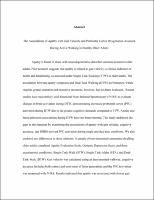Please use this identifier to cite or link to this item:
https://hdl.handle.net/20.500.12202/6885| Title: | The Associations of Apathy with Gait Velocity and Prefrontal Cortex Oxygenation Assessed During Active Walking in Healthy Older Adults |
| Authors: | Holtzer, Roee Foley, Frederick W. Weinberger, Andrea Masur, David M. Facchini, Ronda L. Lee, Jennifer |
| Keywords: | clinical psychology aging gait apathy dual-task Single Task Walking (STW) Dual Task Walking (DTW) neurodegenerative disorders non-demented older adults |
| Issue Date: | May-2021 |
| Citation: | Lee, J. (2021, May). The Associations of Apathy with Gait Velocity and Prefrontal Cortex Oxygenation Assessed During Active Walking in Healthy Older Adults (Publication No. 28547781) [Doctoral Dissertation, Yeshiva University]. PQDT |
| Abstract: | Apathy is found in those with neurodegenerative disorders and non-demented older adults. Prior research suggests that apathy is related to gait velocity, a clinical indicator of health and functioning, as assessed under Single Task Walking (STW) in older adults. The association between apathy symptoms and Dual Task Walking (DTW) performance, which requires greater attention and executive resources, however, has not been evaluated. Recent studies have successfully used functional Near-Infrared Spectroscopy (fNIRS) to evaluate changes in brain activation during DTW, demonstrating increased prefrontal cortex (PFC) activation during DTW due to the greater cognitive demands compared to STW. Apathy and brain activation associations during DTW have not been reported. This study addressed the gaps in the literature by examining the associations of apathy with gait velocity, cognitive accuracy, and fNIRS-derived PFC activation during single and dual task conditions. We also explored sex differences in these relations. A sample of non-demented community-dwelling older adults completed Apathy Evaluation Scale, Geriatric Depression Scale, and three experimental conditions: Single-Task-Walk (STW), Single-Task-Alpha (STA), and Dual-Task-Walk (DTW). Gait velocity was calculated using an instrumented walkway, cognitive accuracy included both correct and error rates of letter generation, and the PFC activation was measured with fNIRS. Results indicated that apathy was associated with slower gait velocity and a change in gait velocity from STW to DTW. Within females, greater apathy was associated with slower gait velocity and greater decline in gait velocity from STW to DTW. Higher apathy endorsement was related to greater change in PFC oxygenation from single to dual task conditions. Within males, higher apathy had a greater increase in activation from STW and STA to DTW. While among females, greater apathy had increase activation from STW to DTW. In the context of neural efficiency theory, those with apathy symptoms may not use their brain resources as efficiently; therefore, requiring more brain resources to complete task-specific demands such as dual tasking without demonstrating performance benefits. As apathy has been found to affect one’s functionality, even within the healthy non-demented older adult, it may be helpful to assess and monitor apathy symptoms. |
| Description: | Doctoral dissertation, PhD / YU only |
| URI: | https://hdl.handle.net/20.500.12202/6885 https://ezproxy.yu.edu/login?url=https://www.proquest.com/dissertations-theses/associations-apathy-with-gait-velocity-prefrontal/docview/2557836834/se-2?accountid=15178 |
| Appears in Collections: | Ferkauf Graduate School of Psychology: Doctoral Dissertations |
Files in This Item:
| File | Description | Size | Format | |
|---|---|---|---|---|
| Lee,J. Final YU only 2021May The Association.pdf Restricted Access | 655.48 kB | Adobe PDF |  View/Open |
This item is licensed under a Creative Commons License

